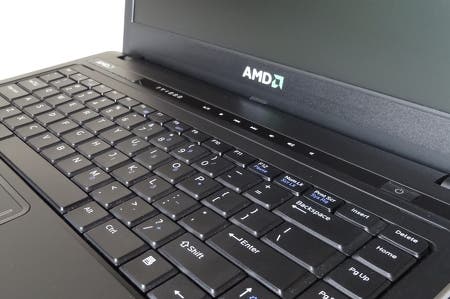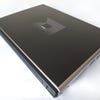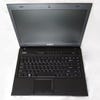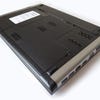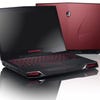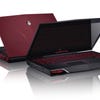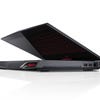AMD Trinity Review
Can laptop integrated graphics beat console visuals? Digital Foundry tests out AMD's latest Fusion quad core offering.
When it comes to buying a gaming laptop, the accepted wisdom up until this point has been simple; integrated graphics processors are well-suited for playing the classics of yesteryear, but venturing into modern territory - games like Battlefield 3 or Skyrim - requires a dedicated, power-hungry GPU: in other words, a serious card for serious gaming. Nevertheless, Intel and AMD's integrated graphics cores continue to gain traction in the laptop market for being cheaper, and more energy efficient than dedicated graphics cores. But for many, these integrated processors simply can't escape the stigma of being the budget choice for gaming, dismissed completely out of hand. The thing is, we've now reached the point where even IGPs can put up a strong fight against the current generation HD consoles - and in some cases, even surpass them.
Cue the long-awaited arrival of AMD's second generation Trinity architecture. This revision sets out to defy common preconceptions of what's possible with integrated graphics, and perhaps more importantly, to make a stand against Intel's popular Ivy Bridge processors and HD4000 graphics chips. This is a bold promise indeed, but given AMD's concurrent position in markets for both CPUs and graphics cards, the potential for it to capitalise here is huge. For the sake of demonstration, we've been sent a prototype laptop by the company to showcase the strengths of its hybrid processor in a practical sense. While this particular unit is unlikely to ever see an actual retail release, the Trinity processor is slowly trickling its way into laptops via other brands, with the most notable entry in the UK market so far being Samsung's NP355V5C notebook.
"Integrated graphics cores are no longer the gameplay jokes they used to be: both AMD Trinity and Intel HD4000 can run Battlefield 3 and Skyrim beyond the console standard."
So what's all the fuss about? The Trinity name is more than for show; it refers to a three-way division of the processing unit that should in theory improve its manufacturing costs and power consumption. First up, there's the A10-4660M CPU, which operates with the updated Piledriver architecture that recently succeeded the Bulldozer series for desktops. This features two sets of two physical cores - essentially represented as a quad core in the Windows task manager, and all cores are clocked at 2695MHz, with the ability to turbo to higher speeds depending on heat and load.
Nearby on the die is the integrated Radeon HD 7660G graphics chip, which has an architectural foundation in the desktop HD 6900 Northern Islands series. This runs at a base core clock of 497MHz that can stretch upwards to 686MHz depending on thermal overhead [Correction: Trinity runs off system RAM and has no attached GDDR5]. Meanwhile, the third part is represented by a new video processing engine, plus multi-display drivers that have their roots in the HD 7900 Southern Islands series. Taken as a whole, this chip is produced at a 32nm manufacturing process with an overall thermal design power (TDP) of just 35 watts. This is AMD's rebuttal to Intel's Ivy Bridge range of i5 and i7 CPUs - but is it enough?
Dissecting the Trinity Laptop
Before we jump into the tests, let's take a look at the kit that surrounds it to get an idea of the nature of laptops it might appear in. The Trinity laptop is notably thinner than our other test unit, the Alienware M14x, which is no doubt buffed outwards by its support of a dedicated NVIDIA GT 650M. Nevertheless, both sport matching sized 14.1 inch LCDs, which appear to be utilising similar twisted nematic (TN) display technology, judging by their unconvincing black levels and poor viewing angles. Resolution for the Trinity laptop is the standard 1366x768 too - potentially a good match for the graphical power it houses.
The unit is stylised in a black and silver motif, and is sturdily built overall with a matte finish that even extends to the coating on the screen. There is no perceptible graininess to the texture of the display as a result when turned on, however, and response times are expectedly solid for the LCD technology in use here, making it an ideal candidate for gaming. That being accepted, there is some noticeable banding on colour transitions with this screen, which can be especially outstanding when lowering and raising the brightness settings with a vivid picture in the background.
"AMD's Trinity prototype achieves over nine hours of battery life for standard web browsing and offered us a creditable three hours for StarCraft gameplay - impressive stuff."
The keyboard offers a satisfying level of give to each tap, and each press results in a light click. Unlike some larger laptops, there's nothing in the way of flex when the centre is pressured. Below the board is a smoothed trackpad which feels proportionately sized for the device, while above it is a touch-sensitive media bar with glowing LEDs behind each button to show when volume is being raised, lowered, or muted. In terms of raw connectivity, we turn to the edges of the device to find two USB 3.0 slots, one for USB 2.0, outputs for both VGA and HDMI, one eSATA connector, an Ethernet port, and a BD-RW drive. There are also standard 3.5mm headphone and microphone jacks at the front, centimetres besides a toggle for WiFi.
Switching it on solves the mystery of its surrounding specs. In support of the Trinity APU is 4GB of DDR3 RAM clocked at 1333MHz, and a 120GB Samsung SSD. While the latter seems like it's little on the restrictive side, given that 30GB PC games like Rage exist and are growing in number, it does at least allow for fast streaming game levels and textures. Battery life is also improved by the removal of moving, mechanical parts we'd find in conventional HDDs, which is tantamount to one of AMD's end goals.
On that note, we're glad to see these measures paying off; for our tests involving strictly light use, our stopwatch reads nine hours and 40 minutes. This decent turnout is achieved on its stock 6-cell battery supply with both screen brightness and speaker volume set to 50 per cent with WiFi engaged. Otherwise, using the very same settings while playing StarCraft 2 at medium settings gives us just a few minutes over three hours of play. Considering that this RTS only takes advantage of a maximum of two physical cores, this figure may be lower for titles like Battlefield 3 where all of the Trinity cores will be engaged. Fortunately, recharging the laptop back up to 100 per cent capacity takes just one hour and 30 minutes overall.
Another major consideration for portable hardware is heat and noise. Running the Hardware Monitor program here gives us no readings from any of the sensors linked to the Trinity processor, but in practise during gaming sessions, we find this gets nowhere near the toasty levels that the M14x hits. The fan is certainly audible on the Trinity under load, but ultimately the bigger distraction is the screeching capacitor whine that occurs whenever movements are made on screen. This manifests as a dull whir that emanates from inside the laptop at the slightest movement of the mouse cursor - hopefully a bug exclusive to our unit, and not a characteristic of the final retail units that will use the APU.
On the plus side, the positioning of the fans means there isn't much in the way of hot air being directed towards your legs. In conjunction with the generally low heat output, this means it's actually possible to use this as a laptop in the most literal sense.
Performance Analysis: Benchmarks
Moving onto the benchmarks, we pit the Trinity APU directly against the closest rival we have to hand: the fourth revision of Alienware's M14x gaming laptop. As a 14.1 inch platform based on the Ivy Bridge architecture, it happens to offer an Intel Core i7 with eight threads and four physical cores, plus the integrated HD 4000 graphics processor we need for testing. Naturally, we switch off the installed discrete NVIDIA GT 650M graphics chip, and simply compare their integrated graphics solutions directly for each benchmark.
First up are the synthetic tests. The latest 2011 version of 3DMark offers us a yardstick based around the strengths of DirectX 11, giving us an idea of how games can perform once advanced lighting and tessellation are involved. Four demanding jungle-themed scenarios play out here that guage graphical capability, followed by one for physics, involving towers tumbling like dominoes, and one last sequence which condenses all of these tests into one torturous stress-test.
Futuremark 3DMark 11: Tested on standard Performance and Extreme settings.
"3DMark 11 scores suggest that AMD Trinity offers a substantial graphical advantage over its expensive Intel rival but that neither has the necessary power for taxing 1080p performance on the most challenging titles."
| AMD A10-4660M (Perf) | Intel i7 3720QM (Perf) | AMD A10-4660M (Extreme) | Intel i7 3720QM (Extreme) | |
|---|---|---|---|---|
| Graphics Score | 1012 | 679 | 340 | 201 |
| Physics Score | 2659 | 6909 | 2646 | 6841 |
| Combined Score | 932 | 802 | 373 | 278 |
| 3DMark 11 Score | P1105 | P799 | X376 | X229 |
In the standard Performance test we see both integrated graphics processors rendering at 1280x720 resolution, while the Extreme preset ratchets that up to a full 1920x1080. It quickly becomes evident that both AMD's 7660G and Intel's HD4000 are out of their league on this higher setting, with the entirety of the test playing out as an hour-long slide-show when we try. In the Performance tests, however, we see much smoother rate of rendering that sees Trinity commanding around a 100 per cent lead in score over the HD4000 in the final Combined test.
That said, Intel's solution does manage to sail to the horizon with a huge lead in the physics-based scores. The scalability of its quad core processor is accountable for this, where its connection to eight active threads may be advantage enough, as compared to just the four on AMD's chip. Intel's advantage over AMD in CPU design is well-known, and this particular processor is one of the best mobile solutions it offers - and it's pricier too, so this disparity is not unexpected.
The overall lead Trinity has here is significant though, and shows promise for performance leads in games, up to and including those using the prevalent Unreal Engine 3. As usual, we opt for Batman Arkham City's in-game benchmark option to get an idea of how both processors perform in either DirectX 9 and 11 rendering modes, with each in combination with FXAA High, 4x MSAA and 8x MSAA. Let the tests begin...
Batman: Arkham City Benchmark: DX9, 1366x768, high detail, PhysX off, all other settings enabled.
| AMD A10-4660M (FXAA High) | Intel i7 3720QM (FXAA High) | AMD A10-4660M (4x MSAA) | Intel i7 3720QM (4x MSAA) | AMD A10-4660M (8x MSAA) | Intel i7 3720QM (8x MSAA) | |
|---|---|---|---|---|---|---|
| Average FPS | 34 | 36 | 27 | 23 | 25 | 15 |
| Min FPS | 15 | 14 | 11 | 3 | 7 | 0 |
| Max FPS | 43 | 44 | 36 | 30 | 34 | 22 |
The benchmark is run here on high detail across the board, with ambient occlusion checked too. It flies us through a few of the game's major locales with a fixed camera, taking us to a goon-filled lair featuring a moving light sources, the entrance to Poison Ivy's botanical den, and the sky-scraping peaks of Arkham City itself.
"The Batman: Arkham City benchmarks reveal that gameplay performance on some releases between the rival integrated GPUs may not be as far apart as synthetic tests suggest."
Here we see the gap widens significantly in favour of the Trinity APU for anything involving the older DirectX 9 version of the test, and this distance in results is only accentuated with each bump upwards in the AA settings. Average frame rates are very close for tests involving High quality FXAA here too, and we find this to inevitably be the most judder-free approach to playing the game, short of lowering the global quality settings to medium.
To follow this up, we run through the same gamut of tests with DirectX 11 enabled. We're initially surprised to find the average frame rates level out at 21FPS for both on FXAA High, where the peaks and troughs are also uncannily close to identical. We notice more screen tearing during these bouts of testing, however, with the bulk of the cuts occurring specifically over light sources
Batman: Arkham City Benchmark: DX11, 1366x768, normal tessellation, high detail, PhysX off, all other settings enabled.
| AMD A10-4660M (FXAA High) | Intel i7 3720QM (FXAA High) | AMD A10-4660M (4x MSAA) | Intel i7 3720QM (4x MSAA) | AMD A10-4660M (8x MSAA) | Intel i7 3720QM (8x MSAA) | |
|---|---|---|---|---|---|---|
| Average FPS | 21 | 21 | 10 | 15 | 5 | 11 |
| Min FPS | 3 | 5 | 3 | 2 | 1 | 2 |
| Max FPS | 29 | 29 | 12 | 21 | 7 | 14 |
Turning on MSAA settings here gives us the complete opposite turnout to that of DX9, and Intel's CPU takes full charge. Frame rates drop dramatically to under playable levels, with AMD's Trinity suffering an especially big hit when sampling is ramped up to 8x. This situation would no doubt have benefited from adding dedicated GDDR5 RAM to AMD's architecture, and extra features such as ambient occlusion and tessellation drag performance down to a choppy 5FPS average.
To double check these issues, we turn to another benchmarking favourite: Metro 2033. In this case, DirectX 11 is selected alongside medium settings, plus with the depth of field check-box ticked. Obviously, PhysX is also disabled here too.
The testing process involves three fly-by passes through an abandoned train station littered with enemies, fire, specular effects and lighting sources. Put into motion, the game at these settings appears ostensibly unplayable for both graphics processors at even these modest settings, regardless of whether we enable 4x MSAA, or 4A Games' modified AAA alternative.
Metro 2033 Frontline Benchmark: DX11, 1366x768, medium detail, PhysX disabled.
"The Metro 2033 scores show that the most demanding benchmark tests can still bring these modern integrated GPUs to their knees, with neither acquitting itself well."
| AMD A10-4660M (AAA) | Intel i7 3720QM (AAA) | AMD A10-4660M | Intel i7 3720QM (MSAA) | |
|---|---|---|---|---|
| Average FPS | 12.33 | 14.37 | 8.52 | 10.38 |
| Min FPS | 6.60 | 10.77 | 5.16 | 7.81 |
| Max FPS | 16.64 | 19.42 | 10.64 | 16.51 |
This time the lead is much more pronounced for Intel's HD4000 processor, and we see it consistently average out at 2FPS or higher than AMD's 7660G. The addition of 4x MSAA cripples performance for each to the same extent, and we see values dropping below 10 even in the less strenuous areas on AMD's processor. It's not a pretty picture, but this benchmarking run is notorious for bringing graphics hardware from all vendors to its knees: max out the settings and even the GTX 680 will struggle to reach 30FPS at 1080p.
Of course, there's a limit to how much raw numbers can relay when it comes to the overall gaming experience. So, as with our Face-Off features, we losslessly capture video of the Trinity laptop playing the most demanding games, and feed that through our frame-rate analysis tools to get a better view of where the laptop falls short and where it excels. As always, Battlefield 3, Crysis 2 and The Elder Scrolls V: Skyrim form our standard gamut of tests, and in each case we match footage with that of the M14x running on the IGP, along with the Xbox 360 and PS3 versions in order to give a console performance perspective. Perhaps we're asking a bit too much here, but we also engage v-sync on the PC comparisons, as screen-tear is so distracting on console.
Gameplay Analysis: Battlefield 3
Jumping in at the deep end, we find running Battlefield 3 at the Trinity laptop screen's native 1366x768 resolution to be a write-off for sustaining 30FPS on higher-end settings levels. Similarly, the medium graphical preset hinders us in hitting that targeted level of performance. Particularly in the opening sequence of the Operation Swordbreaker level, during the stroll around the military camp with your squad, the only way to achieve this is by running the game at 1280x720 at the Low preset. The only tweak we make over and above this is the raising of the FXAA to medium quality, which greatly improves the look of the game at such a low resolution, and typically only at the expense of 1FPS less on average - worth the sacrifice, in other words.
In effect, these settings are remarkably close to those on 360 and PS3, with the noticeable proximity culling for objects and shadow detail. Bearing in mind that this is the lowest end of the graphical scale possible on PC, we're surprised to find that some textures are much improved over their console counterparts in places, and filtering is less intrusive - the dedicated 512MB of graphics RAM clearly has its advantages. One sore spot is the lack of filtering on shadow aliasing, though, which crops up in most globally illuminated areas and remains immune to our post processing. It's with these matching low settings that we have our M14x test the game as well, and the difference in performance is very encouraging.
"Battlefield 3 on low settings with FXAA applied looks better than the console versions in some respects and matches frame-rate is most situations - with v-sync engaged to boot."
Additional Video Analyses:
- Battlefield 3: AMD Trinity vs. Xbox 360
- Battlefield 3: AMD Trinity vs. PS3
Be it in cut-scene or battle, we see the Trinity laptop take a relatively steady lead over the M14x in Battlefield 3. As mentioned before, we shut off access to the Alienware machine's NVIDIA GPU, and the game is running solely off the laptop's Intel HD4000 graphics. Where the frame rate isn't neck-and-neck, we see a 4-6FPS difference to the AMD chip's advantage. It's less clear-cut during battle however, but overall 30FPS is easily sustainable for both platforms at these settings, though the Trinity laptop is more likely to hold out at 34FPS for long stretches.
By comparison to the console versions in these terms, we're spared the constant tearing, but frame rate is slightly worse during that initial section where your squad gathers. Outside of this, like-for-like moments are identical, and we even see gains on the Trinity laptop side during shoot-outs. This is another encouraging result.
Gameplay Analysis: Skyrim
Swapping Frostbite 2 out for Bethesda's Creation Engine, we move on to The Elder Scrolls V: Skyim to see how the Trinity APU handles large environments and long draw distances in this massive fantasy world. In keeping with the standard set by Battlefield 3, we set the resolution to 1280x720 and find the setting which best suits our 30FPS target.
For this case, as with all our previous laptop tests, we find the high preset remains a snug fit. The only cause for concern here is the 8x MSAA that's selected by default, which we swap out for the less processor-intensive FXAA. As is standard, we run our analysis over the very first cut-scene, where your unnamed prisoner character is being transported downhill by horse-cart to Helgen village. This stresses most platforms to a greater degree than the general, free-roaming run of play can, owing largely to the number of NPCs condensed into one area.
"The Trinity APU eclipses both Intel HD4000 and PlayStation 3 in terms of frame-rates, at Skyrim's high graphical preset - though MSAA is swapped out for the cheaper FXAA."
Additional Video Analyses:
- Skyrim: AMD Trinity vs. Xbox 360
- Skyrim: AMD Trinity vs. PS3
The results show an even more consistent lead for the Trinity APU over the M14x's Intel i7 processor than in Battlefield 3. The 30FPS target-line wavers in and out of reach for both laptops, depending on the segment of the journey, but overall it's AMD's chipset which comes out on top for most of the trip. This is can be by a matter of 4FPS, though they both average out at the target frame rate once settled in the town.
Unfortunately, performance simply doesn't quite holds its own against the 360 version, which locks itself to 30FPS for much of the route downwards, albeit with tearing. However, Trinity does command a marginal lead over PS3 for the most part.
In all, the results are to the credit of the AMD's laptop, particularly when considering how much further afield draw distances for objects, geometry and NPCs are on the selected high preset. Running off the SSD also allows textures to stream in more immediately, where we notice the rocks on the walls for the PS3 version popping in when we're mere inches away.
Gameplay Analysis: Crysis 2
Last but not least, we put Crysis 2 through its paces across all formats. In keeping with our previous tests, and to better match the resolutions of the console versions, we set the resolution to 1280x720 and roll the settings all the way down to the lowest preset, bewilderingly named 'high'.
As our previous benchmarks have already highlighted, the Trinity APU's difficulty in handling rendering techniques such as tessellation remains an issue here. The game can't be enjoyed at anything close to a consistent 30FPS during the prologue mission, and so we simply find ourselves turning this off to preserve playability. Similarly, the high resolution texture pack is disabled, although not by choice - it's simply blanked out by default due to the lack of dedicated RAM.
"The integrated GPUs struggle with Crysis 2's effects work and we had to drop down to 1024x600 in order to achieve a consistent 30FPS in all gameplay scenarios."
Additional Video Analyses:
- Crysis 2: AMD Trinity vs. Xbox 360
- Crysis 2: AMD Trinity vs. PS3
To best test CryEngine3, we run through the opening submarine sequence, which gives us a faceful of particle and water effects coupled with the presence of multiple allies up-close. This inevitably proves to be the weakest point during analysis of the Trinity laptop, which only affords itself a refresh of 20FPS for much of the swimming sections. This proves to be quite comparable to the PS3's performance here overall, though the 360 has a much more convincing stab at holding the full 30 here - though once again, Microsoft's platform is liable to tear frames occasionally near the top of the screen.
The situation turns around for the better once we hit the streets of New York, where we see the AMD machine ably hitting that same target, and matching consoles platforms. In comparison to the M14x, results are mixed: the myriad of effects during the submarine collision gets the better of both laptops, but Alienware's 14-incher clears around 2FPS on average over its rival. In later sections the roles are reversed, meaning that, by and large, it's close enough to call it a tie.
Of the three games subjected to the spotlight, Crysis 2 shows the least flattering results. As proved to be the case with the game on other mobile platforms, we find the best way to improve the standing of its performance is to lower the resolution. Sure enough, dropping the values down to the netbook-standard of 1024x600 has a huge impact, and brings the frame rate back into comfortable 30FPS territory for almost every scenario.
Overall, it's a shame that we have to make practically every concession possible to get Crytek's game into a playable state on the Trinity laptop, but on the plus side, the visuals are still impressively detailed even at this ground-level preset.
AMD Trinity: The Digital Foundry Verdict
All in all, the improvements made to overall performance in AMD's latest revision of the Trinity architecture are impressive, but not quite as drastic as we'd hoped. Yes, it has the edge in our synthetic tests with 3DMark 11, but in our gameplay tests, the results are much closer to Intel's HD4000 than we would have expected. Now, the quad core i7 is considerably more expensive than Trinity - AMD typically excels in price vs. performance contests, so we also ran all of our gameplay analyses with two cores disabled on the Intel platform, in order to approximate a dual core chip running the HD4000 GPU - something a bit more comparable price-wise to Trinity. It made little difference to the Skyrim and Crysis 2 performance levels, but Battlefield 3 really struggled, dipping below 20FPs. Generally speaking, games prefer stronger GPUs and most titles still target dual core systems, but Battlefield 3 is clearly an exception.
"Trinity proves that you can enjoy top-tier games on an integrated graphics core but our feeling is we're a year or so away from IGP performance that comprehensively bests current-gen consoles."
Regardless, the fact that it was so close surprised us. AMD's big response to Intel's current generation of processors succeeds in immediate terms, but its R&D departments will need to dig much deeper in order to compete with the upcoming Ivy Bridge successor, dubbed Haswell - rumoured to bring a 2x-3x performance boost over the current hardware. Its handling of DirectX 11 titles also needs addressing, as the current revision came across as somewhat under-optimised in many of our benchmark tests.
The silver lining is this though; the Trinity APU is capable of convincingly holding its own against the console standard. For games like Battlefield 3 and Skyrim at least, achieving a 720p30 output at graphical presets in a very similar ballpark to these versions is definitely a reality for this small processing unit - not a result to be scoffed at given its excellent battery life, low rated TDP and heat output. Crysis 2 is the only real odd-one-out here, where the laptop struggled to maintain a 30FPS refresh, and lacked the resources to run the higher resolution textures.
So what of Trinity's future? Given that the scant selection of laptops currently using the architecture cost just shy of the £600 mark, such as the Samsung NP355V5C, there's no doubt that it's a cheaper option than most laptops equipped with the high-end Intel Core i7 CPU we use for testing. It's also encouraging to see the laptop fulfil its promise of improved energy efficiency; it tallies up a reasonable three hours of battery life while gaming, and almost ten during light web browsing.
The only complaint here isn't usability, but its cost in the grand scheme of the market. Put into perspective, the Acer Timeline Ultra M3 we reviewed recently can be purchased for a similar price, and features a dedicated NVIDIA GT 640M GPU for vastly improved gaming performance. Alas, dedicated cards continue to be the most cost-efficient conduit for modern gaming on a laptop, and for AMD, its hybrid processor needs to be either cheaper, more powerful - or preferably, both - to be truly compelling.
